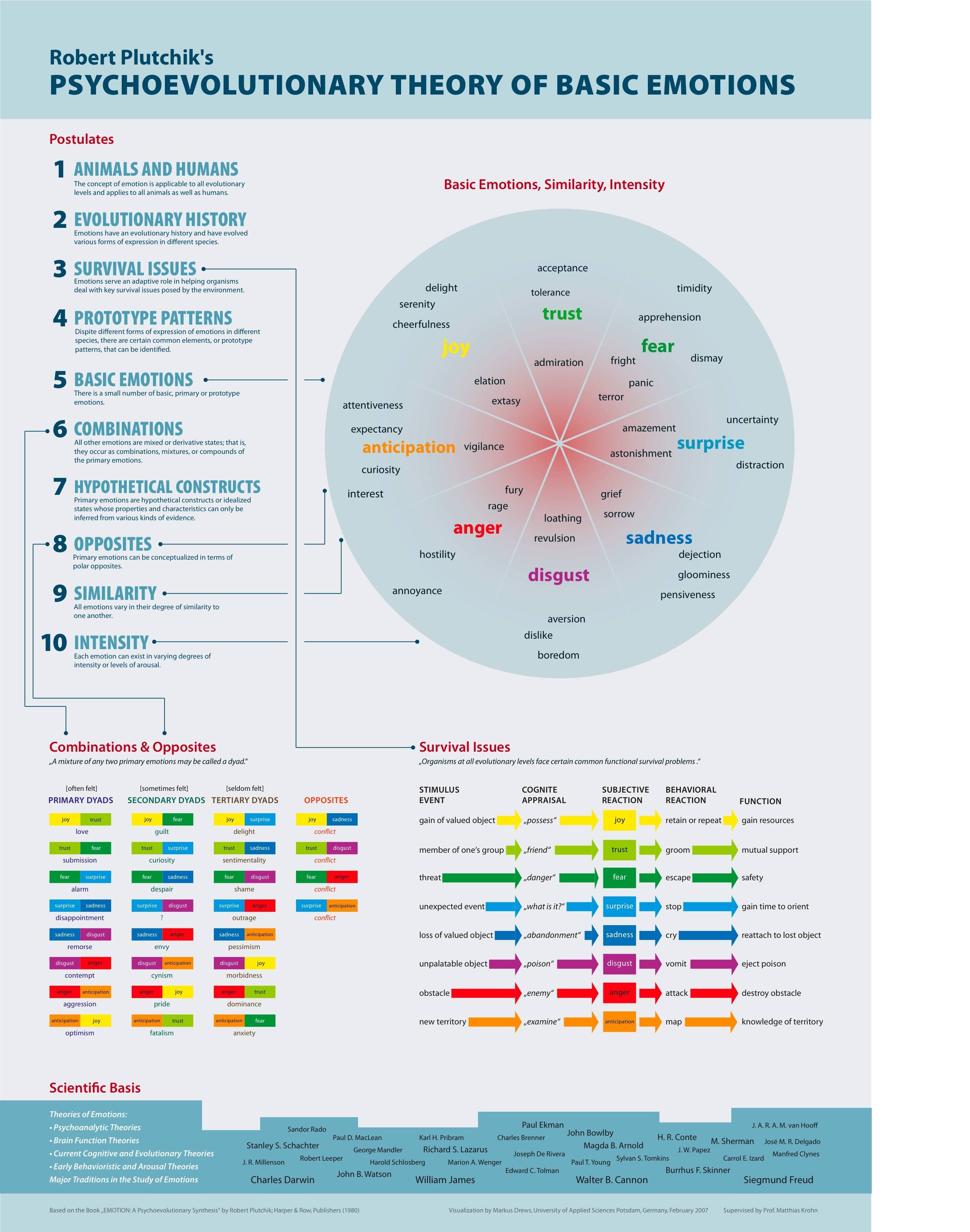The power of emotion
A couple of weeks ago I gave a little talk on the power of emotion in advertising. I thought I’d share a little of it because there are some nice examples.
I have also included a handy little PDF on emotions from Robert Plutchick that adds more depth than in the presentation I gave. In particular it shows our evolutionary response to those emotional stimuli. For example in the case of being presented with an unpalatable object (say a cigarette full of gunk and not tobacco) we appraise that as poison which stimulates digust. Our reaction to disgust is to vomit and eject the poison. And that model helps us to understand why disgust is sucha powerful emotion in advertising if you want people to change behaviour (like give up smoking) and not just change their attitudes.
I kicked off with a quote that we love at Saatchi & Saatchi because it feeds directly into the philosophy behind Lovemarks and helps people understand that emotional potency is a better route to effectiveness than pure rational communication.
“The basic difference between emotion and reason is that emotion leads to action while reason leads to conclusions”. Its by a chap called Donald Calne who plies his trade as a brain scientist.
I then backed this up with some data from the excellent IPA book by Peter Field and Les Binnet on Marketing in the Era of Accountability. There is a whole chunk of stuff that uses the IPA Effectiveness dataMINE to show that on virtually any conceivable metric emotional involvement beats rational persuasion in getting result delivered. Seriously worth getting a copy from the IPA.
Then I wanted to talk about fundamental human emotions rather than whitter on about the sort of emotions we write into the usually pointless and bland tone section of our creative briefs. I wanted to show that communications can create an intensely emotional response in the viewer and that meant understanding real emotions not marketing emotions – remembering of course that emotion is the highest form of interaction. As luck would have it in a rather serendipitous moment I stumbled across Paul Ekman who apparently isolated five fundamental emotions in the early seventies. He did this studying tribespeople in Papua New Guinea because they were free from Western cultural conditioning.
So here are the five commericals each representing one of the five emotions. Clearly I reckon you feel the emotion very clearly but that may be because I’m a sensitive old soul. See what you think.
Joy
Anger
Sadness
Disgust
Excitement
Remember this is not about what you think watching these films but what it makes you feel. You don’t have to be excited by the idea of football to feel you pulse racing.
I kind of wrapped it up though by making a plea for more than executional emotion (utterly powerful though that is). Rather that at best brand should be emotional to the very core.
And that it pure Lovemarks territory. In other stopping using communications to get people interested in the stuff brands care about and instead re-engineering brands to care about the things we all care about.
Which returns me to my traditional gig about brands having a position and not a positioning.
You may thinks all bullshit – but it works for me.
Here’s the PDF of Plutchick’s work.
It looks like this which is quite funky.

Image courtesy of awwwww.cc
Discover more from
Subscribe to get the latest posts sent to your email.


who thinks its bullshit, shouldt work in advertising i think. this is the only thing that can work online, offline, outdoor, indood, etc…
who thinks its bullshit, shouldt work in advertising i think. this is the only thing that can work online, offline, outdoor, indood, etc…
Hello Richard.
Great post – really like the way you set up the argument. Agree wholeheartedly with your final point: that the best brands aim to stir emotions with everything they do and not just with their advertising executions.
I think that this requires a constant interrogation of what the brand’s purpose is over and beyond selling its products, i.e. what’s its role in the world? I’ve written a bit more on that point here: (http://donttellmymum.com/2008/11/05/how-brand-value-comes-from-answering-one-simple-question/)
Cheers,
Nick
Really like the argument Richard, but remain stubbornly mystified by what Cadbury’s position is. Didn’t they claim that Gorilla was all about joy? That’s an emotion not a position that inspires the emotion, isn’t it?
seems more than a little familiar ;)
but absolutely right none the less
This is a hugely important topic.
Millward Brown analysis also supports the importance of emotions.
Couple of points worth emphasising.
The emotions need to be generated in the viewer. This sounds obvious – but – it could be that an ad’s rational message is so powerful, it generates a strong emotional response in the viewer.
Second – it looks from our data that the most sales effective advertising is a combination of rational and emotional. How does one square that with the Field/Binet analysis, which emphasises emotional only? Well, their book gives a couple of examples of what they describe as emotionally based campaigns. One is the Cravendale milk campaign. We’d describe that as emotional and rational – the cows want the milk BECAUSE IT TASTES SO GOOD. so it is worth bearing in mind that one man’s emotional campaign is another mans rational and emotional.
But, whatever – emotion is important in advertising.
(Also – while I disagree with some parts of the Binet/Field “Marketing in the era of Accountability’ book, I think that overall it is an excellent contribution – well worth reading)
Great post. Referenced at http://barnettblog.blogspot.com/2008/11/power-of-emotion.html
Millward Brown pre-tests have always emphasised the rational at the expense of the emotional. The whole idea of ‘pre-testing’ is rational. It used to be done with animatics (I don’t know if it still is) and it’s hard to convey any emotion in a Pugwash drawing. I think modern advertising planning is all about finding a way for the brand to talk with the consumer emotionally. Incidentally anyone who argues that ‘cows wanting milk back because it tastes so good’ is rational seems to me in danger of losing his reason.
I am a little mystified. if the purpose for the whole post is making people feel emotional when you advertise a brand is a good thing – then obviously most of the time this is right.
At least two of the emotive examples you give are sound failures of advertising and are written up as advertising that hasnt worked.
Unfortunately, people in advertising agencies think emotional advertising is the best and always prefered over rational advertising – this is obviously silly. Further, most people dont understand how emotional advertising works – nor when to use it. For my POV on a similar issue see http://consumerpsychologist.blogspot.com/2008/10/rational-vs-emotional-advertising.html
The purpose of this post is to encourage people to think about the emotional response that they wish the communications to generate in the audience. And to illustrate the power of generating that response by showing people examples and asking them to feel what they feel. I’d be interested in the evidence you have on the poor efficacy of any of these approaches.
People buy allot of things just off of emotion. Especially women. So it is so vital for us to inspire peoples emotions.
“I’d be interested in the evidence you have on the poor efficacy of any of these approaches”.
Isn’t there published evidence from TNS to suggest that Gorilla didn’t work as well as hoped at the tills; outperformed by the market and by key competition.
But wasn’t there a thread on here that debated structural reasons why this might be so? (albeit vehemently countered at the time)
And there is debate about Dove.
However I have to say that neither should be used to undermine the point you make Richard.
Emotional over rational every time.
Is that the Dove campaign that has just won an IPA effectiveness award and which delivered a return on investment of $3 for every $1 spent on the campaign?
Dominic – re: the Cravendale case – the Cravendale IPA paper says “The overwhelming reason for purchase of Cravendale is ‘Taste’…So we decided to make taste core to Cravendale’s positioning and to communicate it in a different way.”
So DDB thought there was a rational element in their positioning! But clearly it is expressed in an emotional way.
As to Link; what can I say? I’m sorry you feel that way. We specifically upgraded Link in 2005 to better address emotional elements. And have been doing a huge amount of work with the neuroscientists at Bangor University to explore these issues. Maybe we’ve not shared the findings from this enough.I’d be very happy to discuss outside this forum, or forward some of the papers if it interests you.
Happy to give you Dove mate … anyhow I said the merits were being debated, and I believe they still are.
I’m a fan: always have been.
Hmmm … but you’ve gone quiet on Gorilla?
you did say you were interested in the evidence?
I’ve said before that Gorilla was brilliant but flawed and so there may be structural reason for Gorilla performing as it does.
Neither undermines what you say, which I have to believe is right, but is there evidence, real evidence, to justify it?
(damn the spam)
I use new improved ‘spam-away’ Jemster
tastes swell too !
Great post – at Added Value we use Plutchick’s taxonomy as well when categorizing emotions, though our Brand Connections approach focuses squarely on understanding the emotions at play in an anticipated brand experience – we are not as interested in whether the ad make people feel one way or another at that moment, or how people felt about the ad itself.
People make decisions (eg, choosing one brand over another) by imagining how they will feel having made the decision. The brand acts as a kind of ’emotional shorthand’ (or as Antonio Damasio would say, a somatic marker) in this process.
To this end Adam’s point is spot on – its not a question of Emotional or Rational advertising; what impact does an ad have on how people expect the brand experience will make them feel?
if you say so